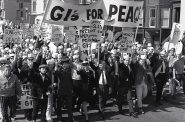A panel discussion at MAM
You may recall the controversy that swirled around the Milwaukee Art Museum and the opening of the Summer of China exhibitions. The internationally renowned Chinese artist, Ai Weiwei (pronounced Eye Way-way) was suddenly and inexplicably taken into police custody on April 3. The whereabouts and charges against Weiwei were a matter of speculation, even after his release on bail June 22, with news that he faced presumably questionable charges of tax evasion. Artists and art museums cried out against his detention, and local creative lightening rod Mike Brenner shaved his head in protest outside of MAM.
Debates in the community and media argued that MAM should commit to some sort of gesture to address the situation. Museum director Dan Keegan acknowledged the situation, but declared that the museum was a place for education and discussion, rather than a locus of political activism.
However, MAM organized a panel discussion Thursday, July 7, to specifically talk about Ai Weiwei, his art, his detention, and how this figures against the backdrop of the Chinese political environment. The assembled panel participants were an admirably mixed group, each offering a distinct perspective and opinion. The participants included Melissa Chiu, director of the Asia Society, New York; Kathryn Kanjo, chief curator of the Museum of Contemporary Art, San Diego; Barrett McCormick, professor of Political Science at Marquette University; and MAM’s own chief curator Brady Roberts.
If you’ve heard the name Ai Weiwei but are unfamiliar with his work, Ms Chiu’s talk would have been an excellent primer. Her overview began with his initial exhibition as a participant in the risky, renegade Stars show in 1979, an early avant-garde, DIY venture featuring artists who hung their work outside a park across from the China Art Gallery (now the National Art Museum of China) in Beijing. It attracted official, but not complimentary, attention. Chiu traced Weiwei’s career through a decade in New York, from 1983 to 1993, and finally his return to China and creation of works as biting commentary on social conditions in his native country. One of his most famous and provocative pieces from this time is Dropping a Han Dynasty Urn (1995). This work, captured in photographs, is strong in its performance element and mirrors the loss of Chinese architecture and neighborhoods, destroyed during the Beijing building boom of the 1990s. As a metaphor for this loss of physical history and heritage, Weiwei held an ancient vase in his hands, and let go. It smashed into pieces, lost forever.
Brady Roberts, in his overview of the planning stages of the Summer of China, revealed that works by Ai Weiwei were under consideration to bring to Milwaukee, and plans had progressed far. The installation of Circle of Animals / Zodiac Heads was to grace our city, but as events unfolded, the owner of the sculptural group withdrew and sent the work to New York as a means of gaining a higher profile and stronger commentary on the artist’s detention.
McCormick, the political scientist from Marquette, held the unique perspective of the evening. The context of the Chinese communist government is unavoidable for an artist such as Weiwei, who is especially known for his use of social media and consistently provocative, clear-eyed commentary. He is a gadfly to the political powers, in a way calling to mind the position of Socrates in ancient Athens. McCormick introduced a broad historical view of China, noting that the country long enjoyed a place of political power and wealth, which had been diluted only during recent centuries. This, he described, was an anomaly and now the world stage was reverting to a more typical geopolitical balance. When asked if he thought the international protests concerning the treatment of Ai Weiwei changed minds in Beijing, resulting in his release, he offered an unequivocal no. The Communist party, which had just celebrated its 90th anniversary in China, was one “dedicated to getting and keeping power.”
In a global culture, these discussions shed new light on the world around us and sharpen own perspectives. The controversy is not diminished, but we can’t help but be more aware of our high premium on artistic freedom, which is especially ingrained in our Western values. Also in light of our traditions, we can’t help but debate these topics. MAM may not have taken the same position of other museums in overtly vocal protest, but should be commended for offering this platform for intelligent, and important, discussion.
Art
-
Winning Artists Works on Display
 May 30th, 2024 by Annie Raab
May 30th, 2024 by Annie Raab
-
5 Huge Rainbow Arcs Coming To Downtown
 Apr 29th, 2024 by Jeramey Jannene
Apr 29th, 2024 by Jeramey Jannene
-
Exhibit Tells Story of Vietnam War Resistors in the Military
 Mar 29th, 2024 by Bill Christofferson
Mar 29th, 2024 by Bill Christofferson






















Thank you Kat for an informative feature. Today I’m visiting the exhibition with my grandson, age 11. Then we’re having lunch at Arby’s. That says it all doesn’t it? A current New Yorker Magazine has a lengthy article (Han Dynasty) about a young Chinese chap named Han. Check it out. He talks about Weiwei.